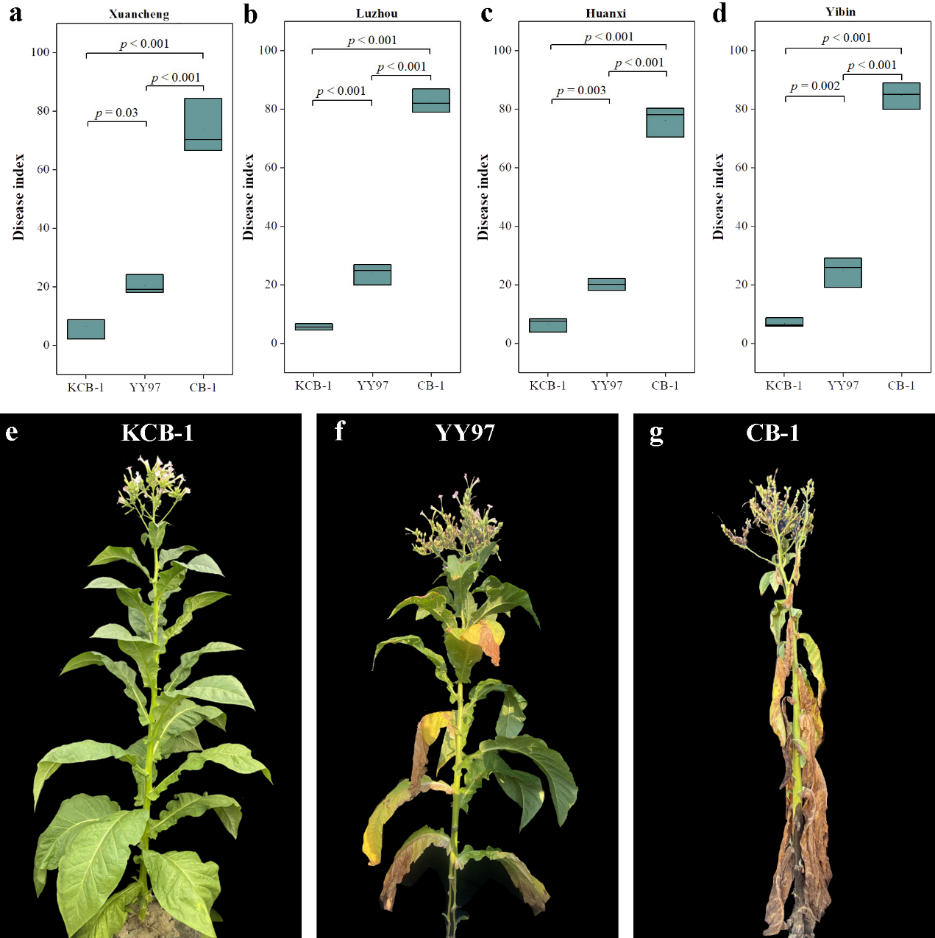
Links
A series of progress has been made in the research on the mechanism of tobacco bacterial wilt resistance in tobacco
Recently, the Tobacco Functional Genome Innovation Team of the Tobacco Research Institute of the Chinese Academy of Agricultural Sciences has made a series of progress in the resistance mechanism of tobacco bacterial wilt. Relevant research results were published in Genomics (IF2021 = 4.31) and Scientific Reports (IF2021 = 4.996).
Abstract-1
Ralstonia solanacearum severely damages the growth of tobacco (Nicotiana tabacum L.) and causes great economic losses in tobacco production. To investigate the root metabolism and transcriptional characteristics of tobacco bacterial wilt susceptible variety Cuibi-1 (CB-1) and resistant new line KCB-1 (derived from an ethyl methanesulfonate (EMS) mutant of CB-1) after infestation with R. solanacearum, root metabolism and transcriptional characteristics were investigated using RNA-Seq and liquid chromatography-mass spectrometry (LC-MS). Differences in resistance between KCB-1 and CB-1 were observed in several aspects: (1) The phenylpropanoid pathway was the main pathway of resistance to bacterial wilt in KCB-1 compared with CB-1. (2) KCB-1 had more differential metabolic markers of disease resistance than CB-1 after infection with R. solanacearum. Among them, the differential coumarin-like metabolites that affect quorum sensing (QS) and biofilm formation of R. solanacearum differ in KCB-1 and CB-1. (3) KCB-1 inhibited production of the R. solanacearum metabolite putrescine, and the level of putrescine in tobacco was positively correlated with susceptibility. (4) Compared with CB-1, the metabolites of KCB-1 had less differential nitrogen sources during the infestation of R. solanacearum, which was detrimental to the growth and reproduction of R. solanacearum. (5) Both indole-3-acetic acid (IAA) and abscisic acid (ABA) in CB-1 and KCB-1 were involved in the response to R. solanacearum infestation, but the levels of IAA and ABA in KCB-1 were greater than in CB-1 at 24 h post inoculation (hpi). In conclusion, R. solanacearum caused reprogramming of both root metabolism and transcription in KCB-1 and CB-1, and the transcriptional and metabolic characteristics of resistant tobacco were more unfavorable to R. solanacearum.
Abstract-2
Tobacco bacterial wilt has seriously affected tobacco production. Ethyl methanesulfonate (EMS) induced tobacco bacterial wilt resistant mutants are important for the control of tobacco bacterial wilt. High-throughput sequencing technology was used to study the rhizosphere bacterial community assemblages of bacterial wilt resistant mutant tobacco rhizosphere soil (namely KS), bacterial wilt susceptible tobacco rhizosphere soil (namely GS) and bulk soil (namely BS) in Xuancheng, Huanxi, Yibin and Luzhou. Alpha analysis showed that the bacterial community diversity and richness of KS and GS in the four regions were not significantly different. However, analysis of intergroup variation in the top 15 bacterial communities in terms of abundance showed that the bacterial communities of KS and GS were significantly different from BS, respectively. In addition, pH, alkali-hydrolysable nitrogen (AN) and soil organic carbon (SOC) were positively correlated with the bacterial community of KS and negatively correlated with GS in the other three regions except Huanxi. Network analysis showed that the three soils in the four regions did not show a consistent pattern of network complexity. PICRUSt functional prediction analysis showed that the COG functions were similar in all samples. All colonies were involved in RNA processing and modification, chromatin structure and dynamics, etc. In conclusion, our experiments showed that rhizosphere bacterial communities of tobacco in different regions have different compositional patterns, which are strongly related to soil factors.
